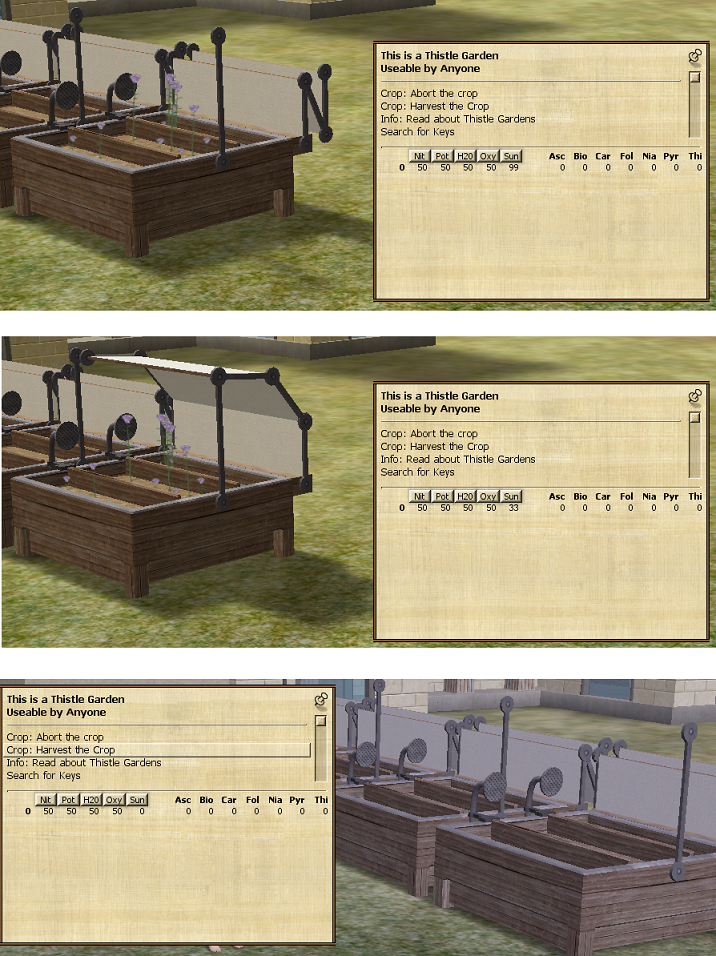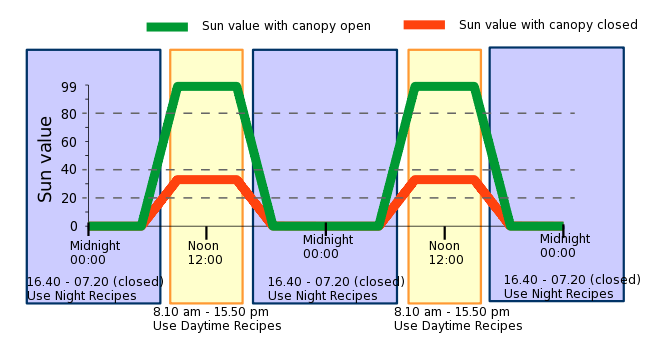The Wiki for Tale 6 is in read-only mode and is available for archival and reference purposes only. Please visit the current Tale 11 Wiki in the meantime.
If you have any issues with this Wiki, please post in #wiki-editing on Discord or contact Brad in-game.
Guilds/Twisted Thistle/Basics
Thistles are arguably one of the most complex plants one can cultivate in Egypt. However, once the would be thistle farmer has understood the mechanism behind how they work, they are no harder than any of the other advanced skills in the game. And since they can be macroed, they are probably even less so. This wiki page here is the first part of a guide aiming to cover all aspects of thistles - both the theoretical base and the know-how for putting this knowledge to practical use. In the current session we will
- Read through the small text on the label your garden came with (all Thistle Gardens in game have an option to read this, so if you have already done so, you can skip this part.
- Learn about how the egyptian date and time can affect thistle growing.
- Master the basics of using a garden without any external help (ThistleSim, Talos' Thistle Tool, or Veggietales). These external tools will be discussed in other sections of the guide with particular focus on ThistleSim.
Small text on the back of your garden
Thistle is a weed that is impossible to kill: if you plant it, it will grow. Thistle is edible to many insects and animals, and it can contain a surprising variety of vitamins. The amount of vitamins produced depends on how the thistle was cared for.
The readout shows five nutrients. You can adjust these directly by pushing the appropriate button. They are:
- Nit (nitrogen, a nutrient, from dung)
- Pot (potassium, a nutrient, from saltpeter)
- H20 (water, a nutrient, applied directly)
- Oxy (oxygen, a nutrient, from aerating the soil)
- Sun (sunlight, a nutrient, controlled using the canopy)
The readout also shows seven vitamins:
- Asc (ascorbin, a vitamin)
- Bio (biotin, a vitamin)
- Car (carotine, a vitamin)
- Fol (folin, a vitamin)
- Nia (niacin, a vitamin)
- Pyr (pyroxiding, a vitamin)
- Thi (thiamine, a vitamin)
As it grows, the thistle converts nitrogen or potassium into vitamins, and it converts vitamins into other vitamins. For example:
- If H20 is high enough, thistle converts Nit to Asc.
- If Sun is low enough, thistle converts Asc to Car.
- If Oxy is high enough, thistle converts Car to Asc.
It will take experimentation to learn all the things that thistle can convert. Once you know what it can convert, and under what conditions, you can encourage it to produce the vitamins you need.
Thistle is affected by day-to-day weather variation. On certain days, thistle just won't do certain conversions. Each morning, you will have to test the thistle to see which conversions it will do, and make your plans accordingly. Active conversions change at Midnight.
Aspects of Nature
First let us establish the main forces driving what can be done with the Thistle Garden and why would you want to grow Thistles in the first place.
Flora and Fauna
- Unlike many of the other plants in Egypt, thistle is not threatened by weeds. Truth be told, it can look a lot like a weed itself, and is known as such in the majority of the known world (it is called a weed even on the garden itself). It is quite likely that it is powerful enough to drive all the other weeds away on its own from the garden. Additionally it does not require any plants near it to be able to grow, and the garden can even be built out in the desert.
Like all other plants, thistle requires water, so make sure not to build your gardens too far from the waterfront (best case: you should be able to fill Jugs while standing next to your Gardens).
- The info text on gardens warns that thistle is edible to many insects and animals. Do not fear though, no wild beetles will ever want to eat it. Nor even any of the other exotic animals you might meet on your travels. Wild sheep are also known to blatantly ignore Thistle Gardens while peacefully grazing next to them.
- By utilizng the latest technology and building a Modern Sheep Farm, you will be able to make the ever-so-reluctant sheep WANT to eat thistles. They get picky though, and require two specific vitamins (varies) out of the thistle being fed to them. Otherwise they simply will not accept it, and their smarmy looks can even make a poor egyptian regret building the farm in the first place! After all, sheep can also be grown in a regular Sheep Pen and just fed Onions.
- The only other creature known to feed on thistles are insects known as Silkworms. Silkworms are exotic creatures imported from distant lands and thus are kept confined in a case made of Sheet Glass at all times (Silkworm Farm). Wild silkworms are yet to be seen in Egypt, but the ones we have provide us with the ever so precious Silk. Silk Cloth can be used to create many wonders, including ribbons for Festivals, gliders for the Test of Flight, or even the majestic Airships. All of this makes silk a very desired commodity, however, the worms only eat thistles, and are even pickier than sheep about the requirements. In fact, the thistle output has 7 different vitamins (abbreviated as A, B, C, F, N, P and T), and worms set a requirement for the amounts of 4 out of these 7 in their food. This is the main reason to grow thistles, but it can also make it rather difficult at times! Silk is considered very valuable and is nearly always in demand, thus resulting in many trades involving it as well.
The Day-Night Cycle
While thistles are not really affected by the Egyptian flora and fauna, they do get affected by nature a lot. In the figure below (Figure 1) you will see the same garden showing 3 different sun values ( The sunlight available for thistle growing is measured in values ranging from 0 to 99). Note the time of day lighting. On the first two gardens, the Sun is up high (it's around 1 pm) and with the canopy open, it's at its maximum value of 99. When the canopy is closed, it limits the available sunlight to 1/3 of 99 = 33. And at night, when there is no sun around to light our path, the sun will always be 0, no matter what.
- When growing thistles it is important to know what time of day it is, since thistle recipes for the given thistle type tend to work either during daytime, or during night hours, but not both.
- You can see the time of day from a small window on top of your screen. The time that the garden follows is Egypt time, not the one your clock is showing. If you don't have the small window showing the date, time, and your current coordinates, you can make it appear by using the following command (type it in chat and hit enter):
/clockloc
On the following figure (Figure 2) you will find an approximate sketch showing when you can safely use which recipes.
- During dusk and dawn the Sun value is constantly changing, making it insanely difficult to get any working recipes with predictable results.
- On the figure (Figure 2), the growing times for night are provided with the assumption that the canopy is closed. With canopy open, night recipes work from around 6 pm to 6 am. The reason for this large difference is that "night time" requires very low sun values, and they come by much faster when the sun is limited to 1/3.
- Hint: you might want to start your garden an egypt-minute later than the time indicated on the figure, just to be sure.
The Egyptian Weather
- The label on your garden warns against changes in the egyptian weather. Apparently thistles are extremely sensitive to changes not noticable by anyone else (with the possible exception of godly beings such as the almighty Pharaoh). Do not bother looking for these changes yourself, as in the egyptian (generally) dry and arid climate they are really difficult to detect. Intriguingly snowstorms, while known to happen once every 3 egypt years or so, do not have any apparent effect on thistles.
- In the process of growing, thistles convert vitamins around between seven types. Every time the weather changes, it is highly likely that some of them will not work until the next weather change. Because "conversions that do not work this time around" is too long to type, a new term has been invented for these. And this terms is:
VOIDS - The stress inflicted by changes in the weather appears to accumulate over time so that in reality, thistles change their voids once a week. Each week lasts 7 Egypt days, and every week on Monday morning at 00:00 the thistle voids change. This is the same time ants change their leaf preferences (probably also due to weather), so it's a more or less safe bet than when someone announces the new leaf type, thistle voids will have changed as well.

